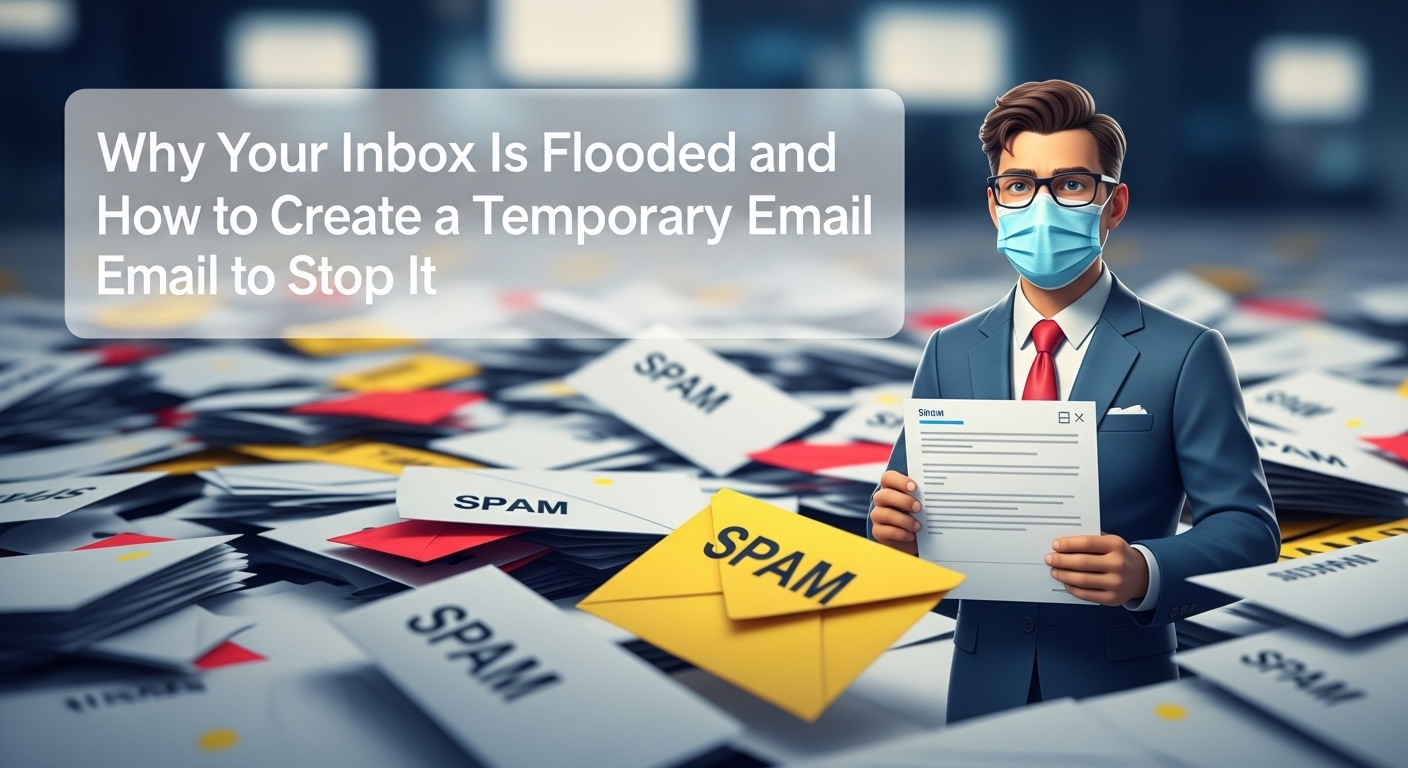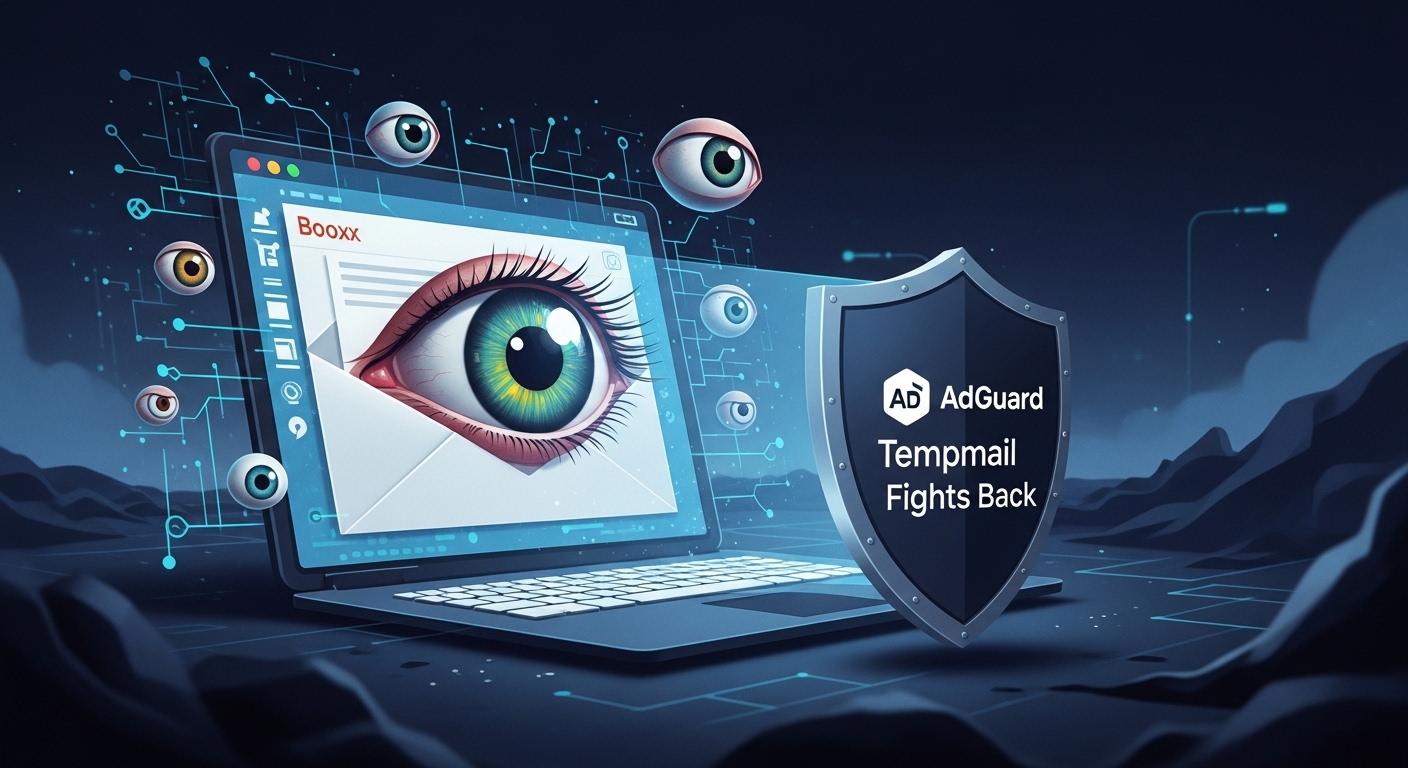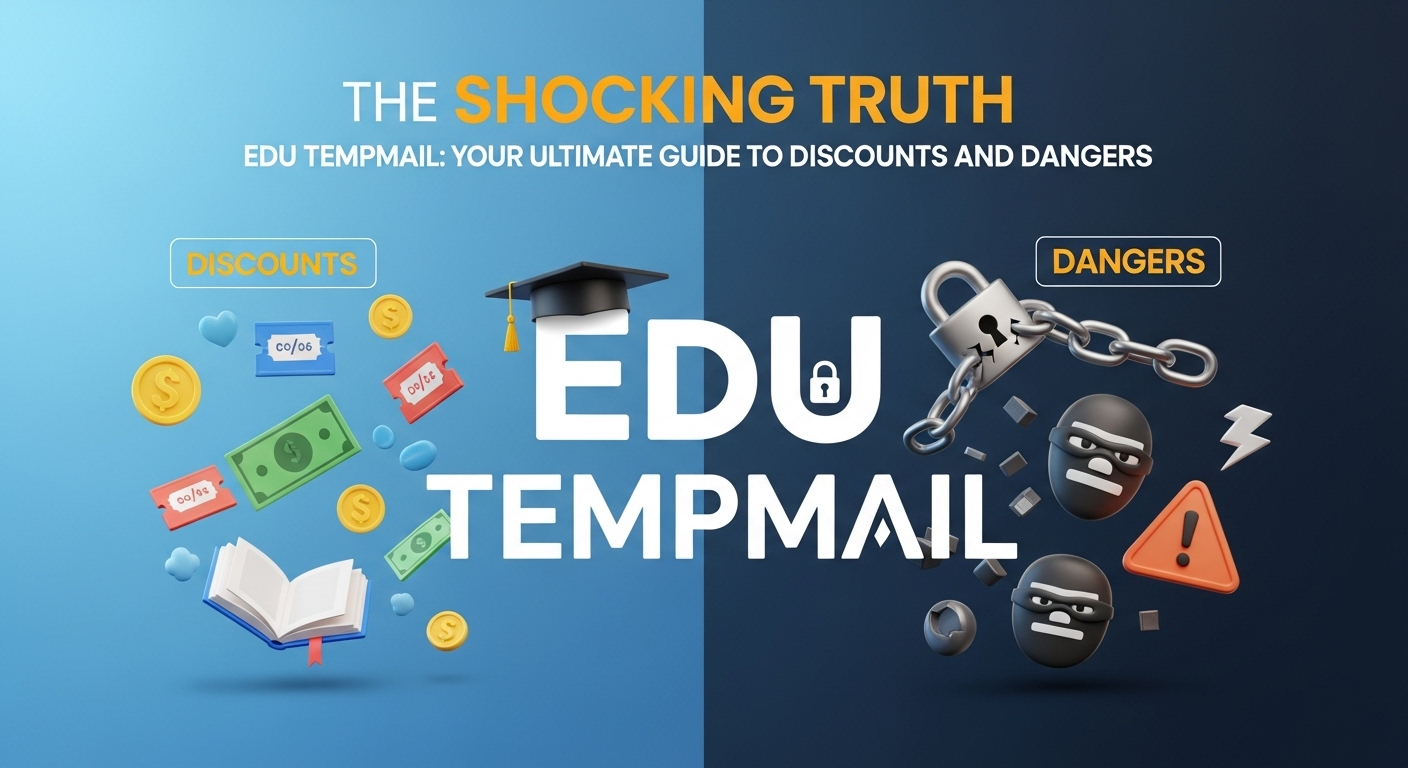Why Your Inbox Is Flooded and How to Create a Temporary Email to Stop It

Is your inbox a war zone? Every morning, you wade through a battlefield of promotional junk, suspicious "urgent" alerts, and newsletters you don't remember signing up for. It feels like a constant, losing battle. You delete, you unsubscribe, but the flood never stops. This isn't just an annoyance; it's a symptom of a fundamental betrayal in the digital world.
The truth is, your personal email address has become a currency you're forced to spend for almost every online interaction. Want to read an article? Download a free guide? Get a 10% discount? Hand over your email. The problem is, you have no real control over what happens next.
Consider the staggering numbers. In 2023, spam messages accounted for a massive 45.6% of all email traffic worldwide. Even more alarming, an estimated 3.4 billion phishing emails—malicious messages designed to steal your information—are sent every single day.
It's no wonder that 92% of Americans are concerned about their online privacy. We're caught in a trap: we need to share our email to function online, but we deeply distrust how companies will use it.
But what if you could create a digital ghost? A shield that takes the hit for you, keeping your real inbox clean and your personal data safe. That's exactly what a temporary email does. It’s your secret weapon in the fight for a sane, secure digital life. To fight back, you need a reliable tool. Services like(https://temptomail.org) offer a first line of defence, giving you control over who can contact you.
This guide will show you everything you need to know. You'll learn how to create a temporary email in less than a minute, discover the best free services for 2025, and understand when—and when not—to use them. It's time to stop the betrayal and take back your inbox.
What Exactly Is a Temporary Email Address?
Before we dive in, let's clear up the language. You've probably heard a few different terms floating around. They all point to the same powerful concept, but understanding them helps you know what you're dealing with.
Temp Mail vs. Disposable vs. Burner
Think of these terms as different nicknames for the same thing. They are largely interchangeable and all describe an email address designed for short-term, single-purpose use.
- Temporary Email (Temp Mail): This highlights the time-limited nature of the address. It exists for a specific period—minutes, hours, or days—and then it's gone.
- Disposable Email: This focuses on the use-and-toss aspect. You use it once for a sign-up or verification and then "dispose" of it, just like a paper cup.
- Burner Email: This term borrows from "burner phones." It implies an anonymous, untraceable address used to protect your real identity before being discarded.
No matter what you call it, the core idea is an email address that acts as a protective barrier between your real identity and the rest of the internet.
The Magic Behind Instant, No-Registration Inboxes
The single greatest feature of most temporary email services is the lack of a sign-up process. You visit the site, and an email address is instantly ready for you. This provides two huge advantages:
- Speed: You can create a temporary email and use it in seconds, which is perfect for quick verifications.
- Anonymity: Since you don't provide a name, password, or your real email address, the temporary address has no direct link back to you.
This frictionless experience is the complete opposite of setting up a traditional email account, which requires personal information and verification steps. It’s this simplicity that makes temporary emails such a powerful tool for quick, private online interactions.
Why You Absolutely Need to Create a Temporary Email Today
Using a temporary email isn't just a clever trick for tech experts; it's a practical, necessary step for anyone who wants to protect their privacy and sanity online. Here are the most compelling reasons to start using one right now.
Benefit 1: Reclaim Your Inbox from Spam Overload
We've all been there. You find an interesting article, a free e-book, or a 10% discount code, but it's locked behind a sign-up form. You reluctantly enter your email, and within minutes, the marketing floodgates open. Suddenly, your inbox is cluttered with daily promotions you never wanted.
- Real-Life Example: You're planning a one-time trip and want to compare quotes from a travel site. Instead of giving them your primary email, which they'll add to a dozen marketing lists, you create a temporary email. You get the quotes you need, and all subsequent promotional emails go to an inbox you'll never check again. Your main inbox stays clean.
This isn't just about convenience. A cluttered inbox makes it easier to miss important messages and increases the risk of you accidentally clicking on a malicious phishing link disguised as a promotion. In fact, studies show that 28% of people unsubscribe from mailing lists simply because the emails feel "too spammy". A temporary email lets you get what you want without ever having to unsubscribe.
Benefit 2: Fortify Your Online Privacy Instantly
Your primary email address is more than just a way to communicate; it's a central piece of your digital identity. It's often linked to your name, social media profiles, online shopping accounts, and sometimes even your physical address. Every time you share it, you're giving away a key that can be used to track your online behavior.
Using a disposable email address breaks this link. For any non-essential service, you can create a new, anonymous identity that has no connection to your real life. This is a powerful way to take back control in an era where 75% of adults feel that tech companies have too much power over their personal data.
Benefit 3: Protect Yourself from Data Breaches
Data breaches are no longer a rare occurrence; they are a constant threat. In 2025, the average cost of a data breach for a company reached a staggering $4.44 million, and these incidents are happening more frequently than ever.
When a website you've signed up for gets hacked, your email address and password are often leaked onto the dark web. If you use that same email and password elsewhere, criminals can gain access to your other, more important accounts.
- The Solution: By using a unique, temporary email for every service, you compartmentalize the risk. If a forum you joined gets breached, the only thing hackers get is a useless, throwaway email address. Your primary accounts—like your banking and main email—remain secure. Given that about one in ten people were notified that their information was exposed in a data breach in the last year, this is not a hypothetical risk; it's a statistical reality.
How to Create a Temporary Email in Under 60 Seconds:
Creating a temporary email is incredibly fast and easy. You don't need any technical skills, and the entire process takes less than a minute. Follow these simple steps to generate your first disposable email address right now.
Step 1: Choose Your Temporary Email Generator
Open your web browser and navigate to a temporary email provider's website. There are many great options, but for this example, we'll use a popular and straightforward service like(https://temptomail.org/). You don't need to sign up or log in.
Step 2: Copy Your New Disposable Address
As soon as the page loads, the service will automatically generate a unique, random email address for you. It will be prominently displayed at the top of the page. Simply click the "Copy" button next to the address to save it to your clipboard.
Step 3: Use It for Any Sign-Up Form
Now, go to the website where you need to enter an email address—whether it's for a newsletter, a free download, or an account registration. Instead of typing your real email, just paste the temporary address you copied in Step 2 into the email field.
Step 4: Check Your Temporary Inbox for Verification
Return to the temporary email service's website. The email you're waiting for—such as a verification link or a confirmation code—will appear in the inbox section on the same page, usually within a few seconds. You can open the email, click the link, and complete your registration. That's it! You've successfully used a temporary email to protect your privacy.
For a visual walkthrough, check out this helpful video tutorial:
The Dark Side: When NOT to Use a Temporary Email
While temporary emails are an amazing tool for privacy, using them in the wrong situation can lead to disastrous consequences. Understanding their limitations is just as important as knowing their benefits. For your own security, avoid using a disposable email address in these critical scenarios.
The Number 1 Mistake: Losing Access to Important Accounts Forever
This is the single biggest risk of using a temporary email, and it's a mistake that can't be undone. Many people create an account for what they think is a one-time use, only to realize later that they need to access it again.
Here’s how the disaster unfolds:
- You sign up for a service using a temporary email that expires after a few hours.
- Months later, you need to log back in to download a past purchase, check a warranty, or simply use the service again.
- You've forgotten your password, so you click "Forgot Password."
- The password reset link is sent to your temporary email address, which no longer exists.
You are now permanently locked out. There is no way to recover the account. Never use a temporary email for:
- Financial Services: Banks, PayPal, cryptocurrency exchanges, or any service that handles your money.
- E-commerce Sites: Amazon, eBay, or any online store where you make purchases and may need access to order history, receipts, or customer support.
- Key Social Media or Communication Accounts: Your primary Facebook, X (formerly Twitter), or any account you use to communicate with friends, family, or professional contacts.
- Government or Healthcare Services: Any official portal that contains sensitive personal information.
The rule is simple: if you might ever need to log into the account again, do not use a temporary email.
The Blacklist Problem: Why Some Websites Block Temp Emails
Businesses are not oblivious to the use of temporary emails. They lose money from fraudulent sign-ups, and their marketing data gets skewed by fake leads that will never convert. As a result, many websites now actively fight back.
They subscribe to services that maintain massive, constantly updated blocklists of domains known to be used by temporary email providers. When you try to sign up with an address from one of these domains, you'll simply see an error message like "Please enter a valid email address" or "This email provider is not allowed." This cat-and-mouse game means that your favorite temporary email service might work on one site but be blocked on another.
The 2025 Showdown: Best Services to Create a Temporary Email
The world of disposable emails is vast, with dozens of providers each offering a slightly different set of features. Choosing the right one depends entirely on your needs. Are you looking for speed, privacy, or advanced features for testing? Here’s a breakdown of the best services in 2025, categorized by what they do best.
For Quick and Easy Use: TemptoMail.org
TemptoMail.org is one of the most popular and user-friendly options available. It’s the go-to choice for millions of users who need a disposable email address with zero hassle.
- Key Features: Instantly generates a random email upon visiting the site, offers browser extensions for Chrome and Firefox, and provides mobile apps for on-the-go use.
- Pros: Extremely easy to use, no registration required, offers a premium version with private domains for better privacy.
- Cons: The free version has minimal security, is ad-heavy, and its domains are frequently blocked by websites. It is also receive-only.
- Best For: Quick, one-off sign-ups where you need a verification link immediately.
For a Longer Lifespan: YOPmail
If you need an inbox that sticks around for more than a few hours, YOPmail is an excellent choice. Its messages are stored for eight days, giving you plenty of time to access them.
- Key Features: Emails last for 8 days, provides a list of alternate domains to help bypass website blocks, and even includes a unique email alias feature to hide your temporary inbox address from others.
- Pros: Longer email retention, ability to choose a custom inbox name, and the alias feature adds a layer of privacy.
- Cons: Inboxes are public and not password-protected. You can only send emails to other YOPmail addresses.
- Best For: Signing up for free trials or accessing content where you might need to receive follow-up emails over several days.
For Developers and QA Testers: Mailinator
Mailinator is a powerhouse built specifically for development and quality assurance (QA) testing. Its system is designed to handle a massive volume of emails for automated workflows.
- Key Features: You can send an email to any address @mailinator.com without creating it first—the inbox is generated on the fly. Its paid plans offer a robust API for automating tests of sign-up forms and email verification flows.
- Pros: Incredibly powerful for testing, no need to pre-register inboxes, and the API is a game-changer for developers.
- Cons: The free version has zero privacy—all inboxes are public and can be read by anyone. Emails are also deleted after just a few hours.
- Best For: Developers and QA teams who need to test email-related functionalities at scale.
For Privacy Fanatics: Proton Mail and Internxt
Sometimes, what you really need isn't a disposable email, but a separate, private one. For this, using the free tier of a secure email provider is the best option.
- Proton Mail: This service is legendary for its focus on privacy. Based in Switzerland, it offers end-to-end encryption, meaning not even Proton can read your emails. The free plan is limited (1 GB of storage and 150 messages per day), but its security is unmatched.
- Internxt: This service offers a free, anonymous, and temporary email generator. It's designed for privacy and doesn't store your personal information. However, its major limitation is that the email address and inbox expire after just three hours of inactivity.
- Best For: Creating a secondary, long-term email account for sign-ups where you want both privacy and the ability to access the account in the future.
Lesser-Known Gems with Unique Features
Beyond the big names, a few other services offer unique functionalities that might be perfect for your specific needs.
- Guerrilla Mail: Its standout feature is the ability to send anonymous emails and even include attachments up to 150 MB, something most free services don't offer.
- 10 Minute Mail: The original ultra-disposable service. It does exactly what its name says: gives you an email address that self-destructs in 10 minutes (though you can extend the timer). Perfect for a single, lightning-fast verification.
- EmailOnDeck: This provider positions itself as privacy-focused, claiming to wipe server logs regularly. Uniquely, its pro version can be purchased with Bitcoin, offering an extra layer of anonymity for those who need it.
Temporary Email vs. Email Alias: Which Is Right for You?
While temporary emails are great for one-off tasks, they have a major flaw: you lose access to them forever. For anything you might need to access again, there's a much better solution: an email alias. Understanding the difference is key to mastering your online privacy.
What is an Email Alias? (The "+" Trick and Forwarding Services)
An email alias is a secondary, forwarding email address that directs all incoming mail to your primary inbox. Unlike a temporary email, an alias is permanent and gives you full control.
There are two main types:
- Subaddressing (The "+" Trick): Many email providers, including Gmail and Outlook, support this simple trick. You can add a + followed by any word to your email username. For example, if your email is myname@gmail.com, you can sign up for a newsletter with myname+newsletter@gmail.com. The emails will still arrive in your main inbox, but they will be addressed to the alias, making them easy to filter.
- Forwarding Services: These are dedicated platforms that let you create multiple, unique aliases that forward to your real email address. They offer far more power and privacy than the "+" trick.
Introducing Power Players: SimpleLogin and AnonAddy
Dedicated alias services act as a privacy buffer for your inbox. When you sign up for a new service, you generate a unique alias (e.g., twitter.alias@simplelogin.com). All emails sent to that alias are forwarded to your real inbox. If that alias starts receiving spam, you can simply turn it off or delete it without affecting your other accounts.
- (https://simplelogin.io/): An open-source service (now part of Proton) that lets you create unlimited aliases with its premium plan. You can reply to emails directly from your main inbox, and the reply will be sent from your alias, keeping your real address hidden.
- AnonAddy: Another popular open-source option with a generous free plan and affordable premium tiers. It offers powerful features like custom domains and the ability to encrypt forwarded emails with PGP.
Head-to-Head: When to Use an Alias vs. a Burner
The choice between a temporary email and an alias comes down to one question: Will you ever need to access this account again?
| Feature | Temporary Email | Email Alias |
| Permanence | Self-destructs (minutes to days) | Permanent (you control it) |
| Account Recovery | Impossible once expired | Always possible |
| Security | Low (often public, no password) | High (inherits security of your main account) |
| Inbox Management | Separate, temporary web inbox | Integrated into your primary inbox |
| Best Use Case | Truly disposable, one-time interactions | Any sign-up you want to keep private but accessible |
Use a temporary email for:
- Downloading a file from a sketchy website.
- Getting a one-time coupon code.
- Entering a contest you don't expect to win.
Use an email alias for:
- Signing up for social media or online shopping sites.
- Subscribing to newsletters you actually want to read.
- Separating your personal, work, and shopping communications.
For most people, an email alias is the superior long-term strategy. It provides the privacy benefits of a disposable address with the control and permanence of a real account.
For Marketers: Safely Researching Competitors
Digital marketers often need to analyze their competitors' strategies. This includes signing up for their newsletters, downloading their content, and going through their marketing funnels to see how they nurture leads.
Using a company email for this would immediately reveal their identity. Instead, marketers can use a temporary email to sign up anonymously. This allows them to observe a competitor's entire email sequence, from the welcome message to the sales pitch, without tipping them off.
For Everyday Users: Securing Online Purchases and Forum Sign-ups
While it's risky to use temporary emails for major e-commerce sites, they can be useful for one-off purchases from smaller, less-trusted vendors. If you find a unique item on a site you'll likely never visit again, using a temporary email with a longer lifespan (like YOPmail's 8-day inbox) can protect you from future spam.
However, be aware of the trade-off: you might lose access to your order history, shipping notifications, or the ability to process a return if the email expires too soon. They are also perfect for signing up for online forums or discussion boards where you want to participate anonymously without linking the activity to your real identity.
The Business Impact: Fraud, Fake Accounts, and Lost Revenue
Have you ever wondered why so many websites block temporary emails? It’s not just to annoy you. From a business perspective, disposable emails are often the primary tool used for large-scale fraud, costing companies billions of dollars each year.
Fraudsters use bots to create thousands of fake accounts with disposable emails to exploit promotions, abuse free trials, and commit loyalty program fraud. This isn't just a minor nuisance; it has a staggering financial impact. Globally, businesses lose an average of 7.7% of their annual revenue to fraud, a figure estimated at over $500 billion. In one documented case, a single large retailer was losing over $600,000 per month just from the cost of sending SMS verification codes to fake accounts created with temporary emails.
Beyond direct financial loss, these "burner identities" cause other serious problems:
- Wasted Marketing Spend: Companies pay to acquire new users and send them marketing emails. When a large portion of their email list consists of fake accounts, that money is completely wasted.
- Skewed Analytics: Fake accounts inflate user numbers and distort engagement metrics. This leads to poor business decisions based on inaccurate data.
- Damaged Sender Reputation: When marketers send emails to thousands of disposable addresses that quickly expire, their bounce rates skyrocket. This damages their sender reputation, causing email providers like Gmail and Outlook to start sending their legitimate emails to the spam folder.
The individual user seeking privacy is often caught in the crossfire of this massive battle between businesses and organized fraudsters. When a website blocks your temporary email, it's because that same tool is being used to inflict millions of dollars in damages. This context helps explain why the "cat-and-mouse game" of blocking disposable domains is so intense.
Conclusion: Your First Line of Digital Defense
In a world where your personal data is constantly being collected, shared, and exposed, taking proactive steps to protect your privacy is no longer optional—it's essential. A temporary email address is one of the simplest yet most powerful tools you can use to build your digital defenses.
It acts as a shield, protecting your real inbox from the relentless barrage of spam, safeguarding your identity from trackers, and insulating you from the fallout of data breaches. By using a disposable address for low-stakes, one-time interactions, you reclaim control over who gets to contact you.
However, with great power comes great responsibility. Remember the golden rule: if you might ever need to access an account again, do not use a temporary email. For those situations, a more permanent and secure solution like an email alias is the superior choice.
By understanding the strengths and weaknesses of both temporary emails and aliases, you can develop a smart, layered strategy to navigate the internet safely. Start today. The next time a website asks for your email in exchange for something trivial, don't give away your digital key. Create a temporary email instead, and enjoy the peace of mind that comes with a cleaner, more secure inbox.
Frequently Asked Questions (FAQ) About Creating Temporary Emails
1. Is it legal to use a temporary email address?
Yes, it is completely legal to use a temporary email address for legitimate purposes like protecting your privacy and avoiding spam. However, using them to commit fraud, abuse services, or engage in illegal activities is against the law. Also, using one may violate a specific website's terms of service.
2. Can temporary emails be traced?
It is very difficult, but not impossible. The service provider may log your IP address, which could potentially be used to identify you. Temporary emails provide a high degree of anonymity for casual use, but they are not a foolproof tool for complete, untraceable privacy.
3. Can I recover a temporary email once it expires?
Almost never. The core feature of a disposable email is that it is permanently deleted after its lifespan ends. Once the address and its inbox are gone, they cannot be recovered.
4. Can I send emails from a temporary email address?
Most free temporary email services are receive-only. The ability to send emails is a rare feature. Some providers, like Guerrilla Mail, do allow you to send anonymous emails, but this is not the standard.
5. How long does a temporary email last?
The lifespan varies dramatically depending on the provider. It can be as short as 10 minutes (with 10 Minute Mail), a few hours (with temptomail), or as long as eight days (with temptomail). Some services keep the address active as long as you have the browser tab open.
6. What is the safest temporary email service?
"Safest" depends on your needs. For true security and encryption, using the free tier of a secure provider like Proton Mail is the best option. For disposable use, the safest services are those that provide private, non-public inboxes and have clear privacy policies about not logging your data.
7. Why do websites block temporary emails?
Websites block domains from temporary email providers primarily to combat fraud, prevent users from abusing free trials and promotional offers, and maintain accurate marketing analytics. Fake sign-ups cost businesses real money and corrupt their user data.
8. What is a better alternative to a temporary email?
For most situations, an email alias service like(https://simplelogin.io/) or AnonAddy is a better alternative. An alias forwards mail to your real inbox, so you never lose access to your account, but you can turn off the alias at any time to stop spam.
9. Can I create a temporary Gmail address?
Gmail does not offer temporary email addresses. However, you can use its built-in "plus alias" feature. By adding a + and any word to your username (e.g., yourname+shopping@gmail.com), you can create a unique, filterable address that still delivers to your main inbox.
10. Are temporary emails safe for receiving sensitive information?
Absolutely not. You should never use a temporary email for anything sensitive like banking information, password resets for important accounts, or personal documents. Many services use public inboxes that anyone can read, and they lack the security features of a standard email provider.
11. How do I create a temporary email for Facebook or Instagram?
You can use any temporary email provider to sign up for social media, but this is extremely risky. If you ever get locked out of your account or forget your password, you will have no way to recover it because the password reset link will go to an email address that no longer exists. It is strongly recommended to use a real email or a permanent email alias for these types of accounts.
You Might Also Like
Is Your Inbox Spying on You? Here’s How AdGuard Tempmail Fights Back
Have you ever paused before entering your email address into a new website, feeling a slight hesitation? That feeling is...

The Shocking Truth About Edu Tempmail: Your Ultimate Guide to Discounts and Dangers
Imagine getting over 60% off Adobe Creative Cloud and half-price Amazon Prime. What if you could get those deals without...

Why Your Hotmail Is a Privacy Nightmare (And How Temp Mail Can Save You)
Did you know that nearly half of all emails sent worldwide are spam? In 2024, spam accounted for a staggering 47.27% of ...

The Ultimate Deception: Is Tempmail Safe, or a Ticking Time Bomb?
Your email inbox is more than just a place for messages. It's the digital key to your entire online life. Every password...

The Ultimate Betrayal: How Your Inbox Is Selling You Out (And How to Use Tempmail to Stop It)
Your inbox is a battlefield. Every single day, a war is waged for your attention, your data, and your money. Don't belie...

Your Digital Shield: The Astonishing Truth About How Temp Mail Works
Opening your email inbox can feel like walking into a battlefield. You’re constantly dodging a barrage of promotional ju...

